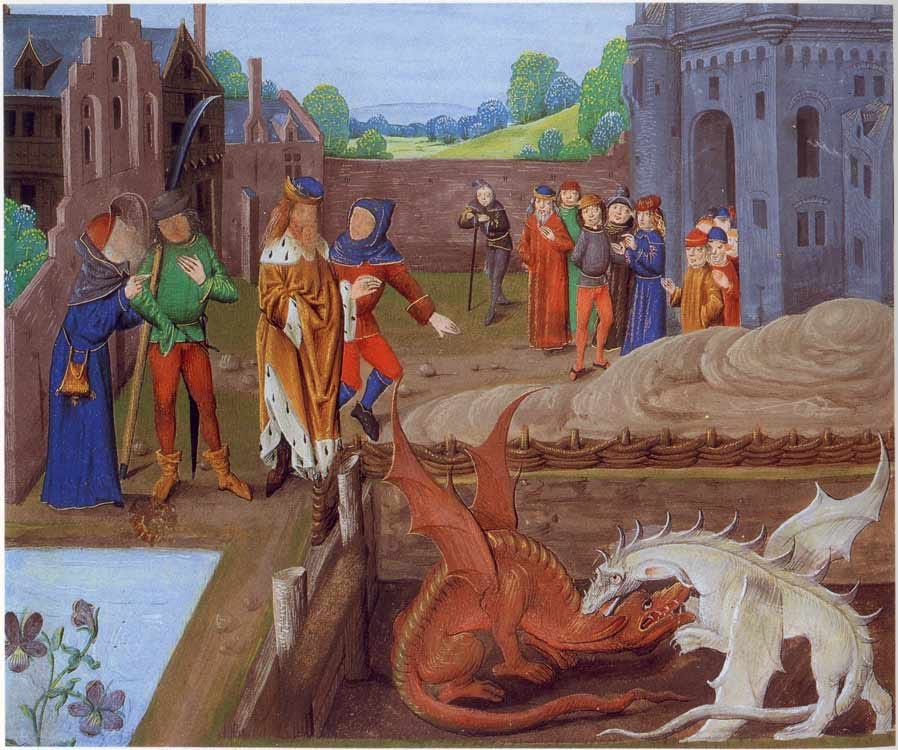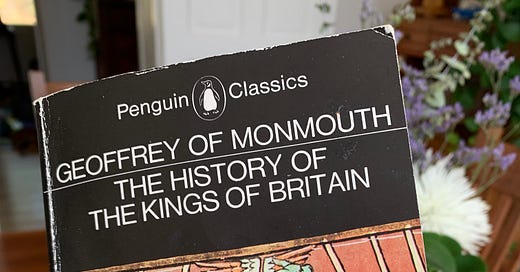Geoffrey of Monmouth’s epic historical narrative, The History of the Kings of Britain (aka Historia regum Britanniae, referred to as HRB), is one of the most popular medieval primary sources since…well, it was written. It has since been debunked as accurate or factual history, due to grand exaggerations and rich embellishments, contradictions, and unreliable sources. But it is still an invaluable primary source, because it exposes the nuanced medieval mindset. It gives us a glimpse into the desires, fears, insecurities, needs, and values of the medieval era. It’s a spectacular epic filled with famous mythological and literature giants from the goddess Diana, to the great mage Merlin, from Vortigern and King Lear, to dueling dragons and prophecies. It’s also one of our first introductions to the most beloved King Arthur which sparked a medieval fervor for all things Arthurian and romance, even influencing other greats writers you might know, such as Chrétien de Troyes, Sir Thomas Malory, and of course, William Shakespeare. It holds immense value for anyone learning about the Middle Ages.
To get as much as possible out of Monmouth’s HRB you have to know the context in which Monmouth was writing. A little background is helpful. The HRB was written circa 1138 CE. In the years Geoffrey was writing, there was much unrest. When King Henry I of England died without a male heir, the nobility refused to recognize his daughter Matilda as queen. Instead, most rallied behind her cousin Stephen of Blois who quickly seized the crown. What ensued was civil war, known as The Anarchy. It lasted around 15 years. England took sides between Matilda and Stephen, barons wrested each other for power and control, and Welsh rebellions increased. It was a time of uncertainty, instability, shifting loyalties, and violence. Geoffrey of Monmouth saw the strife and division and wanted to rally the country to see the importance of revolving around a single character, pushing against the fragmentation, and the pervasive dog-eat-dog mentality. For Monmouth, this single character would be King Arthur. Monmouth also wanted to create a sense of national pride that would embolden the English people in a time of great suffering. Through his characters he gave the people a romantic narrative history that combatted their fears and frustrations with ideals such as honor, pride, hope, and unity.
One of my favorite parts of the HRB is when Brutus, an exile from Troy wandering the globe looking for a place to call home, comes across a temple of the goddess Diana and pleads with her to tell him what lands he should inhabit. Here’s an excerpt:
‘O power goddess, terror of the forest glades, yet hope of the wild woodlands, you who have the power to go in orbit through the airy heavens and the halls of hell, pronounce a judgement which concerns the earth. Tell me which lands you wish us to inhabit. Tell me of a safe dwelling-place where I am to worship you down the ages, and where, to the chanting of maidens, I shall dedicate temples to you.’ This he said nine times…Having sought for slumber, he at length fell asleep. It was then about the third hour of the night, when mortal beings succumb to the sweetest rest. It seemed to him that the goddess stood before him and spoke these words to him: ‘Brutus, beyond the setting of the sun, past the realms of Gaul, there lies an island in the sea, once occupied by giants. Now it is empty and ready for your folk. Down the years this will prove an abode suited to you and to your people; and for your descendants it will be a second Troy. A race of kings will be born there from your stock and the round circle of the whole earth will be subject to them.’” - The History of the Kings of Britain, by Geoffrey of Monmouth (page 65 of my edition).
Monmouth proceeds to tell of a sweeping journey across the map as Brutus goes to find this island. Tales of almost being sunk by the sea-monsters the Sirens, battles against other kings along the way, and after landing in Albion (what the isle of Britain was called back then) fighting giants who were inhabiting the island, pushing them up into caves in the mountains and then dividing the island up amongst his people.
Another great part is The Prophecies of Merlin where Monmouth talks about warring dragons:
“While Vortigern, King of the Britons, was still sitting on the bank of the pool which had been drained of its water, there emerged two Dragons, one white, one red. As soon as they were near enough to each other, they fought bitterly, breathing out fire as they panted. The White Dragon began to have the upper hand and to force the Red One back to the edge of the pool. The Red Dragon bewailed the fact that it was being driven out and then turned upon the White One and forced it backwards in its turn. As they struggled on in this way, the King ordered Ambrosius Merlin to explain just what this battle of the Dragons meant. Merlin immediately burst into tears. He went into a prophetic trance and then spoke…” - The History of the Kings of Britain, by Geoffrey of Monmouth (page 171 of my edition).
Merlin goes on to explain how the White Dragon symbolizes the Saxons and the Red Dragon stands for the people of Britain and how “Britain’s mountains and valleys shall be leveled, and the streams in its valley shall run with blood…The race that is oppressed shall prevail in the end, for it will resist the savagery of the invaders,” (Monmouth, 171). It’s all very fantastical, almost like reading a fantasy novel. I smile that Monmouth claimed his work to be one of history and not fiction, haha.

Monmouth describes Arthur as, “a young man only fifteen years old; but he was of outstanding courage and generosity, and his inborn goodness gave him such grace that he was loved by almost all the people,” (Monmouth, 212). He goes on to describe him as being open-handed in his generosity, just in his causes, having rightful claim through his inheritance to the kingship of the whole island. His tales depicting Arthur’s upstanding character and epic battles are just great. He paved the way for the legends to become just that…legendary.
“Arthur put on a leather jerkin worthy of so great a king. On his head he placed a golden helmet, with a crest carved in the shape of a dragon; and across his shoulders a circular shield called Pridwen, on which there was painted a likeness of the Blessed Mary, Mother of God, which forced him to be thinking perpetually of her. He girded on his peerless sword, called Caliburn, which was forged in the Isle of Avalon. A spear called Ron graced his right hand: long, broad in the blade and thirsty for slaughter….Arthur went berserk, for he realized that things were still going well for the enemy and that victory for his own side was not yet in sight. He drew his sword Caliburn, called upon the name of the Blessed Virgin, and rushed forward at full speed into the thickest ranks of the enemy. Every man whom he struck, calling upon God as he did so, he killed at a single blow...” - The History of the Kings of Britain, by Geoffrey of Monmouth (page 217 of my edition).
I don’t know about you, but passages like this make me giddy. I’m a sucker for all things medieval and all things Arthurian.
Monmouth’s HRB was widely popular and spread like wildfire across Europe. It helped shape the identity of a nation and inspired countless works. Scholar D.R. Howlett says the HRB “generated more imaginative literature than any other text of the entire Middle Ages.”1 The sheer volume of surviving manuscripts is a testament to its popularity. There are at least over two hundred, which is a lot for medieval manuscripts.2 Lewis Thorpe quotes Professor Lewis Jones, “Here was just what a romantic age was thirsting for, and Arthur immediately became the central figure of the most popular and most splendid of the romantic cycles…a hero whose deeds challenged comparison with those of Alexander and Charlemagne,” (Thorpe’s Introduction to the HRB, 21).
If you are wanting an on-ramp into reading medieval primary source material, Geoffrey of Monmouth’s History of the Kings of Britain is a great place to start. It’s not too intimidating and reads like an action novel or like the mythology we loved as children. It might not be entirely accurate, but it does expose you to a lot of medievalisms (is that a word?) and therefore is beneficial and should be required reading for all medievalists. The translation I own and thoroughly enjoy is a Penguin Classics by Lewis Thorpe. I hope you enjoy it as much as I do! Let me know what you think!
RESOURCES & FURTHER READING
Monmouth, Geoffrey. The History of the Kings of Britain
Troyes, Chretien de. Arthurian Romances
Malory, Sir Thomas. Le Morte d’Arthur
Jeffs, Amy. Storyland: A New Mythology of Britain (this book has beautiful illustrations and retellings of many of the stories mentioned in Monmouth’s work. I highly recommend it!)
Article by Miles Russell. Geoffrey of Monmouth: the lost voice of Ancient Britain
Latin 8501A: An illustrated manuscript of HRB from mid-12th century
Peniarth MS 23: An HRB translated into Welsh from the 14-15th century with rare illustrations
D. R. Howlett, “The Literary Context of Geoffrey of Monmouth: An Essay on the Fabrication of Sources,” Arthuriana 5, no 3 (1995): 26.
Crick, Julia. The Historia regum Britannie of Geoffrey of Monmouth (Cambridge: D.S. Brewer, 1985), Vol 3. A summary catalogue of the manuscripts.



Arthur had a spear named.....Ron?
Well thank goodness for Goeff's editing tendencies.